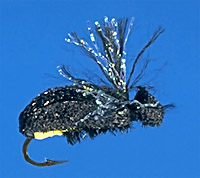STEEVE'S FIREFLY
originally published (September 1-7, 1997)
"Every now and then a fly comes along that just seems to have something going for it. This firefly pattern is one such fly. We have caught fish consistently with this pattern from Tennessee to New York and have reports on its success from many different areas of the country. We do not know what characteristics of this design make it so successful, but it sure works!" -H.R.S.
From: Terrestrials: A Modern Approach to Fishing and Tying with Synthetic and Natural Materials, by Harrison R. Steeves III and Ed Koch. Copyright 1994 by Stackpole Books. Reprinted with permission of Stackpole Books and Harrison R. Steeves.

Materials:
- Underbody: 2 to 4 strands of peacock herl, depending on hook size.
- Hook: #12 to #16 Mustad 94831, Orvis 1638, Tiemco TMC 5212
- Thread: 6/0 Black or Orange
- Body: 1/8-inch thick black closed cell foam; cut into 1/8-inch wide strips.
- Butt: Kreinik fluorescent medium round braid, yellow, #54
- Wings: Kreinik 1/8-inch flat ribbon or heavy round braid, 6-inch piece, mallard, #850.
- Wing Case: Kreinik beetle black, 1/8-inch wide flat ribbon, #005HL.
- Wrap first half of hook shank with thread, tie in 6-inch piece of wing case material to the bend of the hook. Wrap thread forward two-thirds the length of hook shank.
- Tie in body foam and continue to tie it in back to the bend of the hook. This will prevent the body from turning on the hook shank.
- Wrap thread forward about 1/8-inch and tie in a 6-inch piece of butt material. Form the butt on a #14 fly by wrapping the butt material three times and tying it off. Remove the excess. On a #12 fly, four wraps of butt material are necessary. One a #16 fly, only two wraps of butt material are called for.
- Tie in peacock herl just ahead of butt, and wrap thread forward to 1/16 inch behind hook eye. Wrap peacock herl forward and tie down. Wrap thread back and then forward through the herl to reinforce it.
- Fold body foam forward and tie it down about 1/8 to 1/16 inch behind the hook eye (depending on the size of the fly). Cut the forward-projecting foam even with the front of the eye to form the head.
- Tie in a piece of winging material projecting backward to the fluorescent butt. Trim the forward portion flush with the front of the head. Separate the winging material into equal portions on either side of the body.
- Fold the wing case material forward between the wings and tie it down. Trim the excess flush with the head of the fly. Whip finish.
"Tie Tips"
"When tying this fly (and others such as the Japanese beetle or sparkle beetle) save all the trimmed pieces. You can tie a lot of beetles with 6 inches of the Kreinik winging material, butt material, Swiss straw, and others." -H.R.S.
From: Terrestrials: A Modern Approach to Fishing and Tying with Synthetic and Natural Materials, by Harrison R. Steeves III and Ed Koch. Copyright 1994 by Stackpole Books. Reprinted with permission of Stackpole Books and Harrison R. Steeves.
(Thanks to Harrison Steeves, Umpqua Feather Merchants and Stackpole Books
for permission to use this information.)
| Editor's Note |
|---|
| This is the first fly pattern published by FAOL in our first online issue |
For more great info, check out:
Beginning Fly Tying | Intermediate Fly Tying | Advanced Fly Tying.
